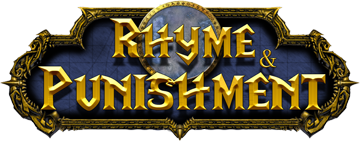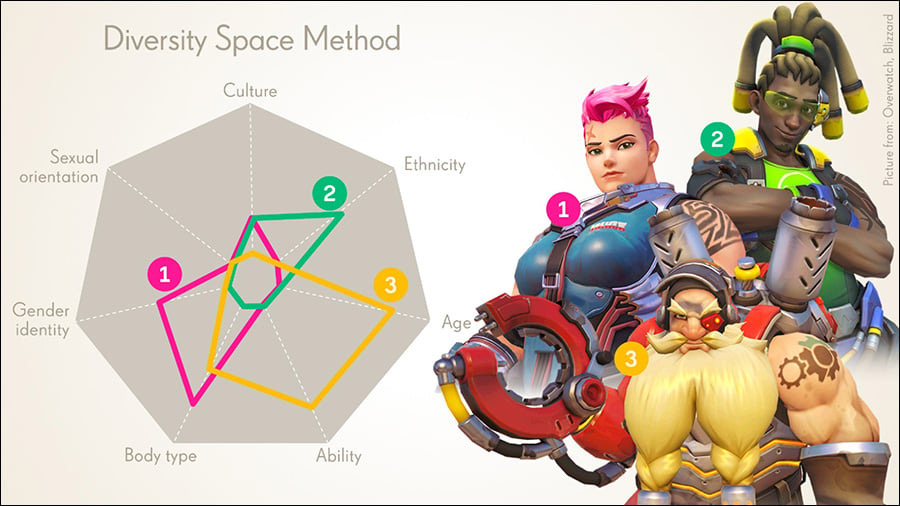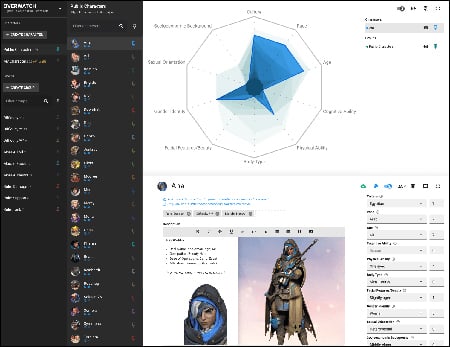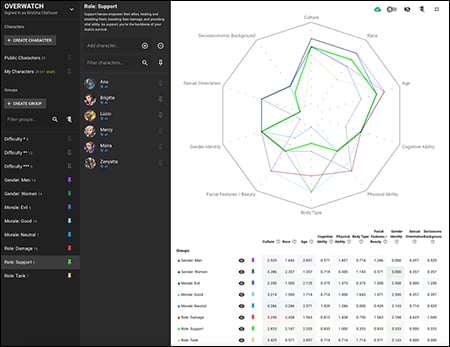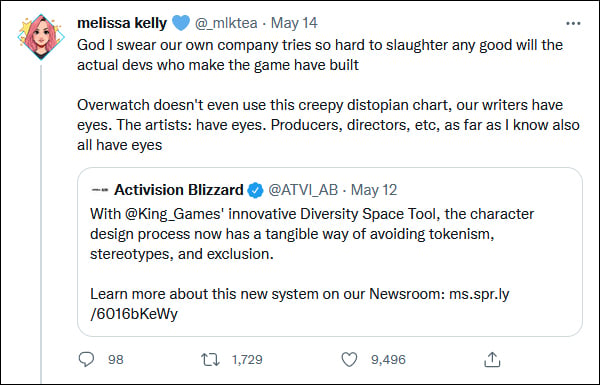A few days ago, Activision Blizzard published a new article titled King's Diversity Space Tool: A Leap Forward for Inclusion in Gaming. In this post, it was found out that King and the MIT Game Lab have been working together to make software in order to "create and monitor guidelines for character conception and creation".
The original post included a header called "Diversity Space Method", featuring different attributes of Zarya, Lucio and Torbjörn in a radar chart.
The Diversity Space Tool also showed a detailed breakdown of Ana and other characters from Overwatch. Ana received a score of 7 out of 10 for culture and race, and 0 out of 10 for body type, sexual orientation and socioeconomic background.
The Diversity Space Tool has been criticized online by the community, after all how is it even possible to "rate" the race and sexual orientation of a character by giving it a score from 0 to 10? Blizzard employees have also criticized the tool, mentioning that Overwatch doesn't even use this "creepy dystopian chart".
In light of the controversy, the original post was updated with an editor's note which clarifies that the tool is not being used in active game development.
Originally Posted by Activision Blizzard
EDITOR’S NOTE (7:42pm PT - May 13, 2022): There has been conversation online regarding the Diversity Space Tool, particularly concerning its intent and our commitment to diversity. We’ve edited this blog post to clarify that this prototype is not being used in active game development. We would like to add the following comment for additional context:
Started in 2016, the Diversity Space Tool–currently in beta–was designed as an optional supplement to the hard work and focus our teams already place on telling diverse stories with diverse characters, but decisions regarding in-game content have been and will always be driven by development teams. The tool was developed at King, and has been beta tested by several developers across the company, all of whom have provided valuable input.
The objective of using the tool is to uncover unconscious bias by identifying existing norms in representation and acknowledging opportunities for growth in inclusion. It is not a substitute for any other essential effort by our teams in this regard, nor will it alter our company’s diversity hiring goals. Over the past several years, the development of the tool was done with the support of all our employee DE&I networks, and we collaborated with external partners to create an even more robust tool.
The tool isn’t meant to be used in isolation; teams would sit down with company DE&I staff to identify existing norms and then discuss, educate, consult, and collaborate on how a character’s representation is expressed beyond those norms. This process is intended to create a conversation where our developers, assisted by the tool, challenge assumptions, assess choices, and find opportunities for authentic representation to be fostered in our games.
Activision Blizzard is committed to reflecting the diversity of its millions of players around the world through representation and inclusion in its games as well as its employees. Our intent with this blog entry was to share an in-progress piece of our journey in this endeavor. We recognize and respect that all people may be on their own, unique point in their journey with DE&I. The Diversity Space Tool is not a definitive evaluation of diversity in game content; rather, it is a bridge in opening previously unspoken conversations into how thoughtful inclusion can happen – and thrive - in games.
We want to see ourselves represented in games, we want the barriers to access lowered, and we want games to be a welcoming environment for all. Just look at the 2019 International Game Developers Association (IGDA) “Developer Satisfaction Survey,” which asked developers what they considered to be the most important factor in the growth of the gaming industry. The most common response? “More diversity in content.” It’s not even a question anymore.
However, the question that does remain is this: How do we convert this feedback from collective desire into tangible reality? As expected, the people at King are already thinking a few moves ahead.
In 2016, King began developing a method for guarding against unconscious bias and exclusion when it came to the creation of their games and characters. At the time, this idea existed as an intangible philosophy, but the potential was obvious.
Enter the MIT Game Lab. Alongside King, the MIT techs helped turn a mission statement into tangible software that would create and monitor guidelines for character conception and creation, looking into all the ways basic elements such as gender, body type, roles (“heroes” vs. “villains”) and even such granular factors such as pose, or body movement, can suggest powerful things about a character one way or another. According to King Globalization Project Manager Jacqueline Chomatas, once MIT handed over the basic software, the team at King spent the last few years honing and developing it, mostly as a volunteer effort. People were spending their off-hours working on the tool, simply because they believed in its potential so much.
“An important principle for us at King is that all players should feel welcome,” says Chomatas. “The intention is to inspire game teams not just at King, but throughout the Activision Blizzard King network, to think outside the box and challenge pre-conceived notions around how characters should look and act. As a result, hopefully we will create more characters that break the mold, and better represent women, non-binaries and other under-represented minorities in the industry.”
How It Works
The idea of a “tool” to make characters more diverse and inclusive may seem a little hard to wrap your head around. In practice, it has to be more than just, say, a pop-up reminder that between 2017 and 2021 nearly 80% of the highest selling games in the world featured white, male protagonists (according to a study conducted by Diamond Lobby). It needs to become a part of the incubation process from the start, baked into the pipeline as an unmissable and consistent step - which is exactly what this tool was designed to be.
“The Diversity Space Tool is a measurement device, to help identify how diverse a set of character traits are and in turn how diverse that character and casts are when compared to the ‘norm’,” explains Chomatas. Once it establishes a baseline for typical character traits (which is done by the creative team working closely with DE&I experts), it can then weigh new character designs against it to measure their diversity. During this process, the tool can also uncover unconscious bias, such as why certain traits are seen as “male” vs. “female,” or why characters from certain ethnic backgrounds are given similar personalities or behaviors.
In this effort, the Diversity Space Tool can clearly delineate between token characters and true representation. “[The tool] identifies what stereotypical characters in different genres look like, which are not always the most conducive or representative of diversity,” says Chomatas. “It helps identify those stereotypes, while also helping creatives look closer at their designs, so they can dissect their own assumptions and presets. It also helps identify opportunities for more diverse character narratives, to ensure that we are not only creating diverse characters in appearance alone.”
By starting at the character conception stage, the tool allows King and others, to ask these important questions at the earliest possible moment, to promote more thoughtful creative choices from the ground up – which, in turn, leads to games that are more representative of their player base.
Sharing and Caring
Over the past few months, King has let developer teams at Activision and Blizzard “beta test” the Diversity Space Tool, and the results have been immediate and enthusiastic. The plan is to further test the tool internally for preliminary feedback across Activision Blizzard starting this summer. “We strongly believe in the tool’s potential to change the gaming landscape,” says Chomatas.
Beyond Gaming
While the Diversity Space Tool was designed for use in game character conception, Chomatas also sees it as having broader applications across all entertainment and media platforms. “The traits and measures are applicable to wider entertainment verticals including TV, film, and literature. The only change required if used in these verticals would be the baseline traits, which would need to be calibrated to be relevant to the genre and universe each character exists in.” Chomatas admits that the application is still evolving – and, in fact, is designed to continuously evolve as “norms” shift and platforms change. In the end, you get out of it what you put into it, and what you choose to take from it.
“Like anything, this is simply a tool that provides insights,” says Chomatas. “It’s up to the teams that create the characters and games to apply them.”
https://www.mmo-champion.com/content/10 ... -in-Gaming
